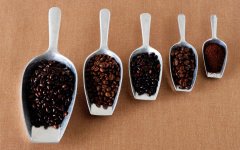The properties of coffee beans during the roasting process of roasted raw beans heated by fried beans Robustas Robbins themselves
The process of fried beans is the main process of heating raw beans and developing the aroma and taste of coffee. The aroma and taste emitted are determined by the original characteristics of each kind of raw bean. The depth of fried beans depends on the type of raw beans, market demand or the way they are cooked. What kind of baking machine controls the depth of fried beans. Even though the chemical and physical components of various raw beans are different, the principles of these ingredients are similar even if they are slightly different in the process of stir-frying.
Baking is a process in which raw beans filled with water are exposed to rapid heating to 400 degrees Fahrenheit (200 degrees Celsius). At this temperature, the interior of the coffee bean produces high temperature decomposition. A brief exothermic process took place. The temperature of coffee beans increased to 392 to 410 degrees Fahrenheit (200 to 210 degrees Celsius), while coffee beans lost 4 to 6 percent of their weight. Raw beans have 12% moisture. From then on, the process of fried beans will lose a total of 16% to 18% moisture. In the process of baking, the more moisture is lost, the darker the color of coffee beans is. The color of coffee beans is also formed in the process of rapid weight loss. Most of the sugar will change and the coffee beans will continue to swell (about twice the size of the original beans) and cracks will appear on the surface at the same time.
At the beginning of high temperature decomposition, about 7.5% of chlorophyll in raw beans decreased slightly, while only about 4% of fried beans were left. The PH value of raw beans was about 6.0. at the beginning of high temperature decomposition, it gradually decreased to 5.5, and then decreased to 4.9 in lightly fried beans. Basically, this process is a dry distillation process that uses thermal decomposition of organic matter in raw beans. The cessation of fried beans when they reach the desired taste is the same as the desired degree of high temperature decomposition and weight loss. The time to stop the stir-fried beans is determined by the depth of the beans in the baking, and also by the temperature of the coffee beans under the temperature control system of the roaster. The key point is that the high-temperature decomposition of sugar and the degree of caramelization determine the ideal taste and aroma of coffee.
There are two speeds of weightlessness in the baking process. The first is slow, which is caused by the evaporation of water in the beans. The second is rapid high temperature decomposition. When the rate of loss of moisture increases, the carbon dioxide in beans increases rapidly. The timing of this transition occurs at the beginning of high temperature decomposition, that is, about 365 degrees Fahrenheit (185 degrees Celsius) or about 10% water loss from raw beans. Although the release rate of 2% of carbon dioxide is calculated, it is possible to release 1% of carbon dioxide in the delicious shallow fried beans. These common fried beans mentioned above are very similar in all kinds of coffee, even if they are very different Robustas (Robbins beans) such as Java coffee. However, these similarities should not be confused with the original size, species, water content, and other factors that affect the development of the ideal taste of each batch of beans.
Important Notice :
前街咖啡 FrontStreet Coffee has moved to new addredd:
FrontStreet Coffee Address: 315,Donghua East Road,GuangZhou
Tel:020 38364473
- Prev

"Coffee Science" Mena reacts deeply baking Italian coffee beans with milk bubbles.
Mena responded that recently more and more coffee shops have set up a roaster in front of the store to bake by themselves, so that they can not only save costs but also control their own quality. So walking on the street, you can often smell the unique aroma of roasted coffee beans, including the burning blue smoke smell of plant fibers, the sweet smell of cream, the brown smell of toast, and so on.
- Next

Factors affecting the degree of baking High Ro baked in lightly fried beans Medium Roast
Factors affecting the degree of baking lightly fried beans contain more acid, so they are suitable for areas where alkaline water is used. Lower-grade coffee beans have the characteristics of poor taste, which can be easily revealed by stir-frying. So usually we use deep stir-fry to drive away the bad volatiles in the beans. From the previous discussion, there are many advantages in mixing baked beans.
Related
- Beginners will see the "Coffee pull flower" guide!
- What is the difference between ice blog purified milk and ordinary milk coffee?
- Why is the Philippines the largest producer of crops in Liberia?
- For coffee extraction, should the fine powder be retained?
- How does extracted espresso fill pressed powder? How much strength does it take to press the powder?
- How to make jasmine cold extract coffee? Is the jasmine + latte good?
- Will this little toy really make the coffee taste better? How does Lily Drip affect coffee extraction?
- Will the action of slapping the filter cup also affect coffee extraction?
- What's the difference between powder-to-water ratio and powder-to-liquid ratio?
- What is the Ethiopian local species? What does it have to do with Heirloom native species?

